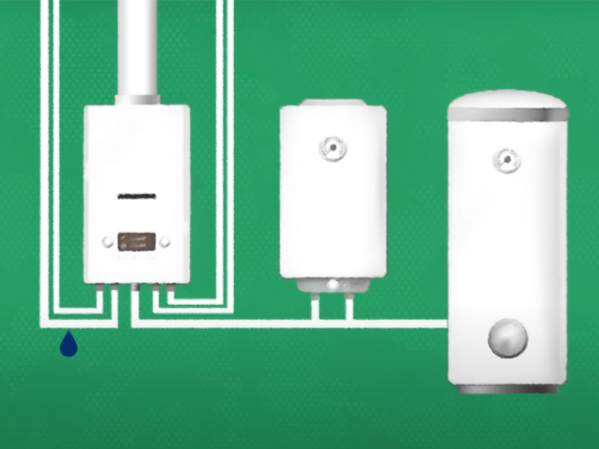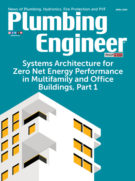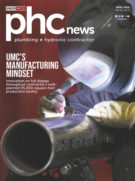Replacing ‘O’ with ‘N’
By Gino Pigozzo and Scott Monroe

It’s 2:00 a.m. on a Monday morning, and the alarm sounds at a copy machine retail store. The facility’s maintenance technician arrives minutes later to find water gushing from the ceiling. He’s too late, of course. In just a short period of time, the water leaking from the fire protection system has soaked several copy machines. The carpet, walls and other equipment in the store are all heavily damaged.
Engineers specify fire sprinkler systems intended to last the life of a new building — 50 years or more. The building owners invest in high-quality pipe, fittings and sprinkler heads at the start, rarely allocating for repairs in the budget.
Corrosion-causing pipe damage begins immediately after the system is installed, and often eventually costs engineers their fire protection system, property and thousands of dollars. Failed fire protection systems can even cause personal injury or loss of life.
Corroded pipe can be repaired or replaced, but requires building maintenance professionals to make weekly or monthly emergency service calls to their fire protection contractor who puts on rubber patch “band aids” or replaces the pieces of failing pipe. It’s rare, however, that the one pinhole leak they repaired or the one section of pipe they replaced is the only issue. Often times, there’s much more going on in the ceiling that is only moments from erupting into total disaster.
The corrosion triangle
In order for corrosion to occur, three elements must be present: iron, water and oxygen. Corrosion cannot happen without all three elements, but when it does, it eats away at pipe in various places, creating holes the size of pins or even pennies.
As the system begins to lose pressure due to the presence of holes, the air compressor kicks in. Eventually the compressor can’t keep up, and the system trips, causing water to enter the pipe and leak through the holes — sometimes in a drip, and sometimes in a gush.
Utilizing nitrogen generators
Oxygen is the corrosion-causing culprit, and luckily it can be stopped. The key to eliminating corrosion is to strip oxygen from the pipe and push in 98 percent or greater pure nitrogen. Nitrogen is an inert gas, which means it prevents electrolysis from occurring by eliminating oxygen from the equation, and rust does not occur.
Nitrogen generators use compressed air forced through a membrane to separate oxygen, argon, helium and water vapor. It captures only the pure nitrogen and stores it in a tank, which is connected directly to the fire sprinkler system’s air maintenance device. This may sound like a complicated process, but installing a nitrogen generator is practically plug and play and is relatively easy. If a contractor can install an air compressor, they most likely have the knowledge they need to install a nitrogen generator.
Dry systems and pre-action systems are perfect candidates for nitrogen generators. Dry systems are common in colder climates and unheated buildings like parking garages. Pinhole leaks in dry systems can cause the dry pipe valve to open and release water. Pre-action systems are common in data centers or other equipment-heavy areas where redundant events, like fire alarms, are required before the sprinkler actually activates. Leaks in pre-action systems cause alarms to sound, but water isn’t released. Nitrogen generation systems work with both black steel and galvanized pipe, which makes them ideal for dry or pre-action systems.
Who should know about nitrogen?
Engineers and architects responsible for specifying fire sprinkler systems are the first line of defense when it comes to building a system that will last. Including a nitrogen generator in the original specifications extends the life of the fire protection system and creates an immediate ROI by essentially guaranteeing a significant reduction in service calls.
Fire protection contractors are trusted partners in building maintenance. Their expertise is invaluable, and they’re heavily relied on for their knowledge and ability to diagnose and solve problems. When a building owner or maintenance technician has hit their pain threshold for service calls and they’ve tired from needing to constantly repair a faulty system, they’ll reach out to other service contractors who can offer a permanent solution. It benefits contractors to keep up with nitrogen generation technology and bring it to the attention of the end-user when it makes sense.
Building owners are savvy, and in a time where everyone is watching their budgets closely, they’re especially critical of repeated service calls. One business recently had multiple problems with its fire system requiring maintenance every month for almost three years. Fed up with how much they were spending on service calls, the business owner did his own research and found nitrogen generation technology online. He hired an attorney and sued the fire protection contractor — and won. They successfully argued that the contractor had a responsibility to provide a reasonable solution to permanently fix the failing system.
Choosing the right nitrogen generator
There are several factors to consider when choosing the right nitrogen generator for a fire protection system.
- Is the system new or is it an older system with an existing air compressor?
- Has the current air compressor gone bad or does it work well enough to meet NFPA-13 fill requirements along with keeping up with system changes?
- How large is the system, and how many systems are involved?
- What is the supervisory air pressure, or the amount of air pressure in the piping system required to hold the valve closed?
- What kind of fire protection system is it — pre-action or dry?
- What is the preferred monitoring method — automatic or manual?
Both the total system size and individual zone capacities will affect the size and number of nitrogen generators required. An automatic system continuously checks to ensure 98 percent or greater nitrogen at all times, and a manual system simply requires someone to check the system on a weekly basis.
Nitrogen generation: It’s worth it
By using nitrogen generation in a fire sprinkler system, annual maintenance costs can be reduced by thousands of dollars each year. The generator itself is low maintenance, and building owners or property maintenance technicians can monitor the system themselves. Nitrogen generation can extend the life of a sprinkler system by decades, whether it’s installed as a part of a new system or later in conjunction with the replacement of damaged pipe.
As with any technology, however, there are some hurdles to mass adoption. For instance, contractors aren’t all trained in nitrogen generation technology and therefore don’t always include it when they work with engineers on fire protection system design or when they go on customer service calls. Despite the technology being around for several years, it has only recently started to get the attention it deserves, and education opportunities are growing. Distributors like Ferguson Fire & Fabrication can assist contractors in getting the proper education, and training on nitrogen systems and nitrogen generator manufacturers offer training and certification programs on the technology.
Upfront costs for a nitrogen generation system also pose a challenge for building owners. Once they do the math, however, it’s typically a no-brainer. Today, a nitrogen generator for a standard 250- to 500-gallon sprinkler system can run on average less than $10,000. The nitrogen generator can save them that much or more each year in maintenance calls to repair or replace corroded and leaking pipe.
Summary
Corrosion is costly. It destroys pipe and causes fire sprinkler systems to fail — and failing sprinkler systems have major consequences. Engineers, architects and fire protection contractors can provide a life-saving solution in the form of nitrogen generation, which will keep pipe from developing pinhole leaks that deem sprinkler systems useless. Nitrogen generators offer immediate ROI by saving the system and eliminating the number of service maintenance calls made to repair or replace corroded pipe.
Gino Pigozzo is engineered products manager with Ferguson Fire & Fabrication. He has been with the company since 2004, and is responsible for educating and promoting Ferguson’s engineered products offering in the southeast, Midwest and Ohio Valley regions. Reach him at gino.pigozzo@ferguson.com.
Scott Monroe is an engineered products specialist with Ferguson Fire & Fabrication. He has been with the company since 2002, and is responsible for educating and promoting Ferguson’s engineered products in the northeast. Reach him at scott.monroe@ferguson.com. Visit www.fergusonfire.com.




